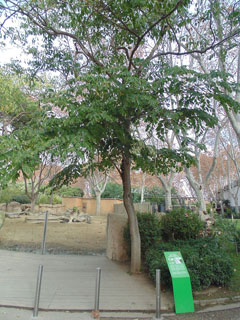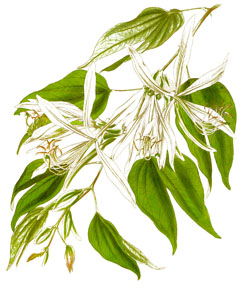 |
|
wikimedia.org User:Leptictidium |
 |
| https://edibleplants.org/ |
Translate this page:
Summary
Brazilian orchard tree - Bauhinia forficata, is a fast-growing, pioneer species. It is a spiny, deciduous or semi-deciduous tree that grows up to 5-9m tall. It has an open and irregular crown and a usually crooked bole up to 30-40cm in diameter. It has a nitrogen-fixing capacity. The leaf of Brazilian orchid tree has been known as remedy for diabetes. It is also an anticholesterolemic , blood purifier, diuretic, hypoglycaemic, and tonic. The wood is soft and moderately heavy, and used for fuel and charcoal making.
Physical Characteristics

 Bauhinia forficata is a deciduous Tree growing to 12 m (39ft) by 10 m (32ft) at a fast rate.
Bauhinia forficata is a deciduous Tree growing to 12 m (39ft) by 10 m (32ft) at a fast rate.
See above for USDA hardiness. It is hardy to UK zone 9 and is not frost tender. The flowers are pollinated by Insects.
Suitable for: light (sandy), medium (loamy) and heavy (clay) soils and prefers well-drained soil. Suitable pH: mildly acid, neutral and basic (mildly alkaline) soils and can grow in very acid and saline soils.
It cannot grow in the shade. It prefers moist soil and can tolerate drought. The plant can tolerates strong winds but not maritime exposure.
UK Hardiness Map
US Hardiness Map
Synonyms
Bauhinia candicans Benth.
Plant Habitats
Edible Uses
Edible Parts: Leaves
Edible Uses: Tea
Leaves (see medicinal uses). An infusion of the leaves is drunk regularly after meals for its health benefits, whilst it is also drunk specifically in the treatment of diabetes, high blood sugar levels, kidney and urinary disorders, to reduce blood cholesterol levels and as a general tonic and blood purifier[ 318 ].
References More on Edible Uses
Medicinal Uses
Plants For A Future can not take any responsibility for any adverse effects from the use of plants. Always seek advice from a professional before using a plant medicinally.
Antibacterial Anticholesterolemic Antidiarrhoeal Blood purifier Diuretic Hypoglycaemic Kidney Leprosy
Skin Tonic Urinary
Brazilian orchid tree leaf has become very popular as a treatment for diabetes ever since research carried out in the 1920's demonstrated its ability to reduce blood sugar levels. The leaves contain a range of compounds including flavonoids, alkaloids, and glycosides. Various trials have been carried out into the health benefits of the leaves, particularly the hypoglycaemic activity. Whilst most of these trials have been positive, at least one was unable to discern positive benefits[ 318 , 739 ]. The main plant compounds in the plant include astragalin, bauhinoside, beta-sitosterol, flavonols, flavonoids, glycosides, guanidine, heteroglycosides, kaempferitrin, organic acids, quercitrosides, rhamnose, and saponins[ 318 ]. Astragalin has well-proven antibacterial activity[ 318 ]. Kaempferitrin, a flavonoid, has been shown to significantly lower blood sugar levels, to have diuretic activity and to help repair kidney cell damage[ 318 ]. The leaves are anticholesterolemic, blood purifier, diuretic, hypoglycaemic and tonic[ 318 , 739 ]. An infusion is drunk regularly after meals for its health benefits, whilst it is also drunk specifically in the treatment of diabetes, high blood sugar levels, kidney and urinary disorders, to reduce blood cholesterol levels and as a general tonic and blood purifier[ 318 ]. Other conditions that have been treated with the leaves include central nervous system disorders, diarrhoea, elephantiasis, intestinal worms, leprosy, obesity, skin disorders, snakebite and syphilis[ 318 ].
References More on Medicinal Uses
The Bookshop: Edible Plant Books
Our Latest books on Perennial Plants For Food Forests and Permaculture Gardens in paperback or digital formats.

Edible Tropical Plants
Food Forest Plants for Hotter Conditions: 250+ Plants For Tropical Food Forests & Permaculture Gardens.
More

Edible Temperate Plants
Plants for Your Food Forest: 500 Plants for Temperate Food Forests & Permaculture Gardens.
More

More Books
PFAF have eight books available in paperback and digital formats. Browse the shop for more information.
Shop Now
Other Uses
Containers Pioneer Wood
Other uses rating: Medium (3/5). Agroforestry Uses: A fast-growing, pioneer species that also fix atmospheric nitrogen (some disagreement - see Cultivation below), it can be used in reforestation projects and, with its small size and fairly open crown, is suitable for use in the first stages of a woodland garden[ 419 , K ]. Other Uses The wood is moderately heavy, soft, of low durability when exposed to the elements. Too small and of low quality for applications other than making lightboxes, light workmanship etc[ 419 ]. Whole trunks and branches are used for fuel and to make charcoal[ 419 ].
Special Uses
Food Forest Nitrogen Fixer
References More on Other Uses
Cultivation details
Brazilian orchid tree is found from the subtropical to the tropical zones. Prefers a sunny position[ 419 ]. Succeeds in a range of soils so long as they are well-drained[ 309 ]. Tolerant of acidic soils[ 309 ]. Established plants are very drought tolerant[ 309 ]. A fast-growing young plant, able to reach a height of 3.5 metres within 2 years from seed[ 419 ]. The wood can be rather weak, leading to branches breaking[ 309 ]. Although many species within the family Fabaceae have a symbiotic relationship with soil bacteria, this species is said to be devoid of such a relationship and therefore does not fix atmospheric nitrogen[ 755 ].
References Carbon Farming Information and Carbon Sequestration Information
Temperature Converter
Type a value in the Celsius field to convert the value to Fahrenheit:
Fahrenheit:
The PFAF Bookshop
Plants For A Future have a number of books available in paperback and digital form. Book titles include Edible Plants, Edible Perennials, Edible Trees,Edible Shrubs, Woodland Gardening, and Temperate Food Forest Plants. Our new book is Food Forest Plants For Hotter Conditions (Tropical and Sub-Tropical).
Shop Now
Plant Propagation
Seed - it has a hard seedcoat and may benefit from scarification before sowing to speed up germination. This can usually be done by pouring a small amount of nearly boiling water on the seeds (being careful not to cook them!) and then soaking them for 12 - 24 hours in warm water. By this time they should have imbibed moisture and swollen - if they have not, then carefully make a nick in the seedcoat (being careful not to damage the embryo) and soak for a further 12 hours before sowing. Seed the seed in a partially shaded position in individual containers. A germination rate of around 30% can be expected from untreated seeds, with the seed sprouting within 15 - 25 days[ 419 ]. They should be ready to plant out less than 6 months later. Cuttings. Layering. Suckers.
Other Names
If available other names are mentioned here
Brazilian orchard treeüBauhinia forficata
Native Range
SOUTHERN AMERICA: Brazil, Peru (east), Argentina (northeast), Paraguay (east), Uruguay (northwest)
Weed Potential
Right plant wrong place. We are currently updating this section.
Please note that a plant may be invasive in one area but may not in your area so it's worth checking.
None Known
Conservation Status
IUCN Red List of Threatened Plants Status : Least Concern

Growth: S = slow M = medium F = fast. Soil: L = light (sandy) M = medium H = heavy (clay). pH: A = acid N = neutral B = basic (alkaline). Shade: F = full shade S = semi-shade N = no shade. Moisture: D = dry M = Moist We = wet Wa = water.
Now available:
Food Forest Plants for Mediterranean Conditions
350+ Perennial Plants For Mediterranean and Drier Food Forests and Permaculture Gardens.
[Paperback and eBook]
This is the third in Plants For A Future's series of plant guides for food forests tailored to
specific climate zones. Following volumes on temperate and tropical ecosystems, this book focuses
on species suited to Mediterranean conditions—regions with hot, dry summers and cool, wet winters,
often facing the added challenge of climate change.
Read More
Expert comment
Author
Link
Botanical References
Links / References
For a list of references used on this page please go here
A special thanks to Ken Fern for some of the information used on this page.
Readers comment
| Add a comment |
|
If you have important information about this plant that may help other users please add a comment or link below. Only comments or links that are felt to be directly relevant to a plant will be included. If you think a comment/link or information contained on this page is inaccurate or misleading we would welcome your feedback at [email protected]. If you have questions about a plant please use the Forum on this website as we do not have the resources to answer questions ourselves.
* Please note: the comments by website users are not necessarily those held by PFAF and may give misleading or inaccurate information.
To leave a comment please Register or login here All comments need to be approved so will not appear immediately.
|
Subject : Bauhinia forficata
|
|
|
|